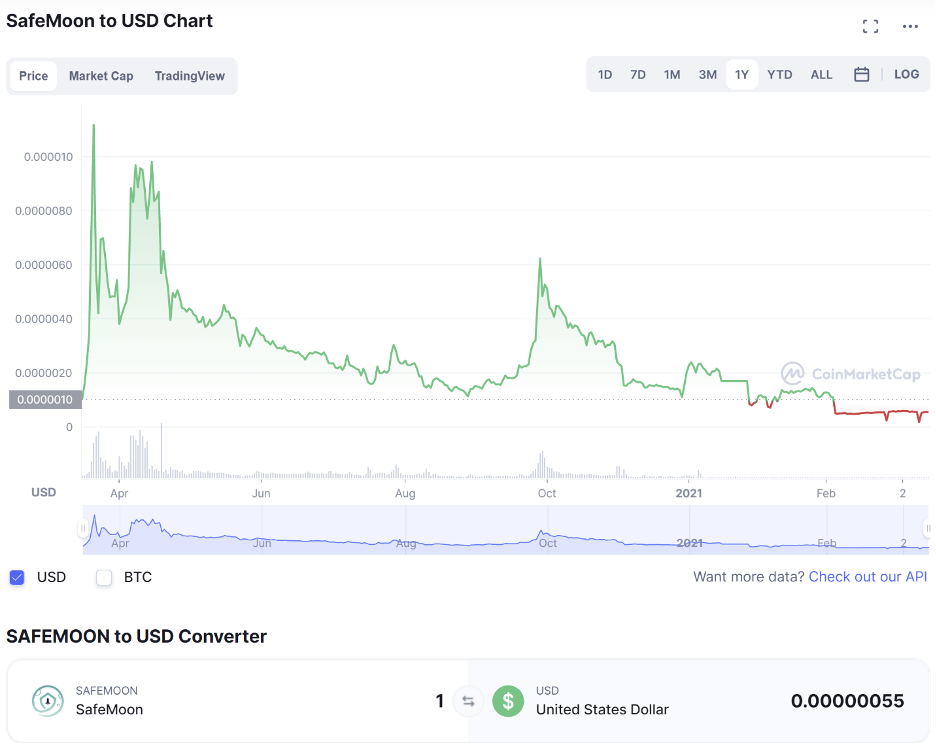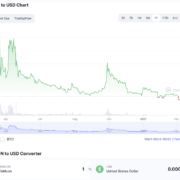One pocket of the asset world that has really taken off in the last few years are the meme assets.
Meme assets don’t just pertain to equities like GameStop (GME) and AMC (AMC).
Truth be told, these assets are incredibly speculative and it's frequent when stock prices don’t mesh nicely with the cash flow or PE multiple.
Crypto also has meme coins which can border on the edge of insanity to the edge of speculation.
These types of bets are for the strong-willed.
Enter SafeMoon.
Coined after the phrase that profits are “going to the moon”, yes, I kid you not, this meme coin has been drumming up quite a following on social media where many of these speculative ideas incubate.
What Is SafeMoon?
SafeMoon is a cryptocurrency token that launched in early 2021, using blockchain technology developed by Binance.
A feature unique to SafeMoon is that it charges a 10% fee whenever you sell the token, well, that was until an upgrade reduced this fee to 2%.
The high fee is explained as a fee that discourages selling, but I would argue that it creates more of a centralized feel to this meme coin and kills liquidity in a marginal coin.
Anybody knows that without ample liquidity, markets can dry up and become untradeable.
In fact, many retail traders I hear from refrain from going too deep into speculative crypto territory for fear that they won’t be able to fill an order upon exit.
For the developers of SafeMoon to force participants into high transaction fees screams scarcity mentality to me instead of focusing on creating a high-quality coin.
This ploy also breeds distrust in the incremental investor who won’t jump off the fence and into SafeMoon if they know they can’t cut losses easily.
SafeMoon takes the proceeds of all sales fees and gives 50% to current token holders in a distribution that is called a “reflection.” The other half of the fee goes into a liquidity pool that SafeMoon uses to maintain price stability.
Rerouting proceeds to existing coin holders are poor practice and a big red flag.
This practice, again, encourages the centralization of the coin which is in fact what many coin holders hate.
The structure is set up to reward only existing participants and clearly, the ones that gain the most are the founders and developers who have skin in the game from the start.
This doesn’t sound too fair to me.
I also noticed that since much of the SafeMoon community is based on social media platforms, members who decide to sell some of their coins are prone to harassment from other members of the social media groups.
Vilifying others for selling an asset is another large red flag.
In the world of buy low and sell high, sometimes traders must take profits, and to frame the selling of one SafeMoon coin as sabotaging the asset speaks volumes about who is involved in this.
I am not interested in being cyber stalked by an unruly SafeMoon mob and most others aren’t as well.
Such a poor mentality would in fact turn off many incremental buyers from pulling the trigger.
SafeMoon does not have any other special use case besides being a store of value. It doesn’t facilitate any automated contracts or decentralized applications, like Ethereum.
Another massive problem with SafeMoon is the challenge of simply investing in it.
Investors cannot buy SafeMoon with the US dollar or any other fiat currency.
The only way to pay for purchases of SafeMoon is with other cryptocurrencies.
To buy it, one must need to buy a coin on an exchange that supports SafeMoon, then use that other coin to buy into SafeMoon.
Ease of transaction is something SafeMoon glamorously fails at.
Another red flag is that no reputable exchanges like CoinBase and Kraken will touch the trading of SafeMoon. It’s also not available on apps like Robinhood or SoFi Invest.
There is no way I could in good faith recommend investing in something so abstract as SafeMoon. I get it that SafeMoon is trying to pour that pixie dust on themselves like Dogecoin, but I have unearthed too many negatives in this coin to ever even consider it aside for a good laugh.
It’s not surprising that the coin has crashed since its debut in 2021.





